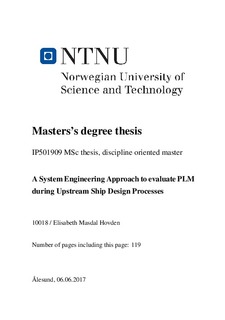| dc.description.abstract | Ship design is a complex and iterative process to design the best possible vessel for a
customer. Inside the conceptualization phase a lot of requirement information, calculations
and documents is created and collected. Product Lifecycle Management (PLM) is
a process to manage these documents and the process itself. An ongoing implementation
process is facing resistance in the company currently regarding the tools chosen and what
it will be like for the employs when the process and tools is implemented. The software
selected consists of a 3D drawing tool with a database of searchable components. Documents
and information is intended to be stored together with this 3D model for the specific
vessel. Re-use of components, assemblies and vessels, and reduced time across design and
engineering phase is the main goal with this new implementation, and to get better control
of the specific projects. The step of shifting from 2D to 3D drawing tool is a big leap for
the company.
The aim of the thesis is to evaluate the PLM process during upstream ship design process
with the stakeholders perspectives conserved. Upstream ship design is the all the phases
from conceptualization and until the vessel is ready for delivery. The scope of this thesis
is limited to the conceptual design phase, were the layout of the vessel is designed.
Systems Engineering approach is applied to investigate the case and collect information
from different perspectives. The PLM process is evaluated based on the findings of the
investigation.
Evaluation shows many good aspects with the use of PLM in the conceptual phase, but
some issues needs to be resolved before making this approach the current state of the art.
One challenge is the assumed time to make the first revision of the ship design. Based on
experience from other companies, the assumed time to design the vessel will increase by
approximately 6 ����� 9%, dependent on the project type. However, when this master model
of the vessel is created, it is assumed a shorter time than before to come up with the second
revision of the General Arrangement. Many positive ripple effect will come from this
3D model, like Bill of Material, revision control, a 3D model which can be exported to
stability software, rendered illustrations of the vessel, and less export between softwares
than now. | nb_NO |

